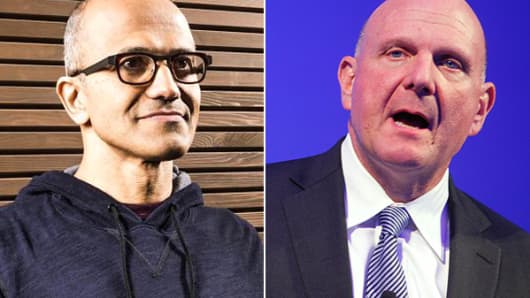The world has been scrutinizing newly-appointed Microsoft CEO Satya Nadella's every move. Early indicators signal a welcome departure from his predecessor Steve Ballmer.
In Ballmer's 12-year tenure, Microsoft was profitable but outpaced by competitors. While Microsoft's market capitalization slid from $288.9 billion in 2002 to $226.8 billion in 2013, Apple's shot from $6.8 billion to $456 billion during the same period. While Apple and Google launched disruptive technology like the Android, iPhone and iPad, Microsoft was often slow to capitalize on advancements in mobile music, smartphones, and tablets (though the success of Xbox and Kinect were surely victories). For example, despite fantastic reviews of the Windows Phone 8.1, it may be hitting the market to late — iPhone and Android have already gobbled up 97 percent of the worldwide smartphone market.
(Read more: Cramer: Hey, Nadella, here's why Microsoft needs a spinoff)
Many are asking, Will Nadella be a better CEO than Ballmer? Perhaps a better question is, Will Nadella drive the right strategy and culture for Microsoft to successfully re-invent itself?
Though a CEO's leadership style is not the sole reason for a company's success or failure, research supports the strong relationship between great leadership and financial performance. Leaders set direction and drive culture that either supports or prevents strategy execution.
On the strategy front, Nadella hinted he'll move away from traditional desktop software and towards a "mobile first, cloud first" approach. With mobile devices and applications like Office for iOS and Android, and cloud strategies like application-hosting service Azure and Office365, Microsoft is well-positioned.
(Read more: Microsoft bets that 'Titanfall' will boost Xbox One sales)
But for Nadella to succeed, he must also transform Microsoft's culture. The culture Ballmer created was characterized by highs and lows. His passion for the company he joined in 1980 was unparalleled. Nadella himself reported learning a great deal from him: to "stay grounded, and to be brutally honest with yourself."
But the very qualities that gave Ballmer his edge were also his downfall. His temper was the stuff of corporate legend. Microsoft insiders recount screaming matches with Ballmer, and according to software engineer Mark Lucovsky, Ballmer indeed threw a chair when he resigned to work for Google. In 2013, Ballmer's approval rating was a mere 47 percent compared to Facebook's Mark Zuckerberg (99 percent), Google's Larry Page (95 percent) and Apple's Tim Cook (93 percent).
Why was Ballmer's leadership style the wrong fit for a company needing to reinvent itself? It's likely that his intense competitiveness created a culture that undermined innovation. There are many examples, but perhaps most telling was the company's employee stack-ranking system, which "encouraged people to backstab their co-workers." (To Ballmer's credit, he did eliminate this system in November 2013).
In contrast to Ballmer's "larger than life" approach, Nadella helped employees to see him as a human being first. In his first letter to employees, he shares the important role his family plays in his life and admits to buying more books than he can finish.
(Read more: Icahn's eBay war: The Street vs. Silicon Valley)
As a leader, Nadella is a walking contradiction; he possesses the rare ability to focus on people and results — without sacrificing one for the other.
On the results side, he's a tenacious leader who seems determined to shift focus away from traditional software. He notes that "our industry does not respect tradition — it only respects innovation." And to truly innovate, rather than trying to be all things to all people, Microsoft must "pick the unique contribution that we want to make."
On the people side, Nadella's collaborative style is a perfect fit. Many leadership thinkers argue that, to successfully innovate, leaders must foster a culture of cooperation rather than competition. Microsoft's products and services must integrate across platforms and devices. So instead of fostering competitive fiefdoms, Nadella must help employees partner and innovate across boundaries.
Finally, whereas Ballmer was inclined to hog the spotlight, Nadella's humble nature will allow employees to take center stage. Nadella hails the value of empowering "every individual," expressing confidence in employees' "talent, resources and perseverance."
Because of his unique qualities as a leader, Satya Nadella is likely to accomplish what Ballmer could not: transforming Microsoft's culture, delivering an agenda of true innovation, and gaining a foothold against competitors. Indeed, he believes that Microsoft can truly "improve other people's lives" — it seems that he'll begin with his own employees.
— By Tasha Eurich
Tasha Eurich is an organizational psychologist, speaker and author of "Bankable Leadership: Happy People, Bottom Line Results and the Power to Deliver Both." She has a PhD in industrial-organizational psychology from Colorado State University and serves on the faculty of the Center for Creative Leadership. Follow her on Twitter @TashaEurich.


